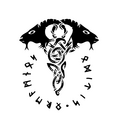In Norse paganism, offerings are a central part of ritual practice; they build relationships between gods and humans through acts of respect and reciprocity. If you’ve asked “What do I offer the Norse gods?” you’re asking the right question. Offerings aren’t random gifts. They’re intentional, symbolic gestures rooted in tradition, spirit, and personal connection.
This guide explores the types of offerings associated with each major god or goddess and provides examples of both traditional offerings and modern tools you can incorporate into your own practice.
What Counts as a Proper Offering?
Offerings can take many forms. Some of the most common include:
-
Poured drinks (mead, ale, milk, wine)
-
Food (bread, berries, butter, nuts, meat, eggs)
-
Burned incense or herbs
-
Symbolic items (iron, bones, carved staves, feathers)
-
Handmade objects or tools
-
Spoken word (songs, poems, oaths, praise)
-
Devoted action (acts of service, physical work, sacrifice of time)
What matters most is intention. Offer what feels respectful and meaningful, not just what’s convenient or aesthetic.
Offerings for Specific Norse Gods
Odin – The Allfather, God of Wisdom and War
Odin values knowledge, sacrifice, discipline, and intent. He often receives offerings related to death, transformation, and seeking deeper truths.
Traditional offerings include:
-
Mead or whiskey
-
Iron or bones
-
Ravens’ feathers
-
Spoken poetry or oaths
-
Long hours of study or sacrifice
Offerings and tools made for Odin:
Freya – Goddess of Love, Beauty, War, and Seiðr
Freya is associated with sensuality, witchcraft, independence, and fierce protection. She responds well to heartfelt offerings and beauty.
Traditional offerings include:
-
Mead, honey, or milk
-
Roses, herbs, or flowers
-
Art, singing, or dancing
-
Blood (in very serious ritual contexts only)
-
Jewelry or small valuables
Offerings and tools made for Freya:
Thor – God of Storms, Protection, and Strength
Thor is direct, forceful, and loyal. His offerings reflect strength, stability, and everyday protection.
Traditional offerings include:
-
Beer, bread, or hearty meals
-
Iron tools or hammers
-
Thunderstones (naturally occurring stones)
-
Loud or physical displays of gratitude (drumming, stomping, etc.)
Offerings and tools made for Thor:
Loki – God of Change, Chaos, and Cunning
Loki thrives in liminal spaces. He responds to offerings that reflect cleverness, irreverence, or chaos, as well as sincerity.
Traditional offerings include:
-
Candy, spicy food, or unconventional treats
-
Alcohol (especially anything with a bite)
-
Jokes, riddles, written confessions
-
Acts of defiance or trickery (used ritually)
Offerings and tools made for Loki:
Tips for Giving Offerings
-
Use a dedicated offering bowl or plate, not your everyday dishes.
-
Burn herbs or incense safely in a fireproof vessel.
-
Clean your altar space regularly.
-
Speak aloud or silently, but always with intention.
-
Dispose of offerings respectfully (in nature, compost, or burial, when appropriate).
If you’re ready to go deeper into Norse ritual work, including creating bindrunes, building altars, and structuring your offerings, check out:
→ Norse Ritual: Bindrunes, Offerings & A Guide for Norse Pagans


